William Conor RHA PRUA ROI (1881-1968) Water Buckets Oil on canvas, 59.5 x 44.5cm (23½ x 17½'') Signed; signed again and inscribed with title and dated 1923 verso Provenance: Important Irish Art Sale, these rooms, 8th October 1987, Catalogue No.26, where purchased by current owner. Literature: Illustrated Irish Times 23rd January 1988 Review of the Year, where they thought it fetched a 'possible record price'. William Conor began his career as a lithographer in David Allen & Sons in Belfast and this early training has certainly contributed to his unique style and technique as an artist and colourist. Conor believed that the artist should record his own epoch and give expression to that which is happening around him. (Máirín Allen, October 1942). In 1944 Richard Rowley wrote of Conor; He has devoted all his manhoods years to the praise and glory of the city which gave him birth; he has immortalised her beauty, and the steadfastness of her people, in works which will last to carry her fame to remote generations�Ǫ (Dictionary of Irish Artists). The artist himself was aware of the transitory nature of the scenes and society he was chronicling, and he anticipated their passing, ...when we have trampled on the best of the past and sacrificed everything of value to the much vaunted name of progress I trust these paintings and drawings will recall a world that is quickly disappearing and could soon be forgotten. (The Peoples Painter). Water Buckets is a lively and uplifting composition featuring two happy women carrying buckets up a steep hill. A row of houses in the village or town behind them are wonderfully rendered as a pleasant contextual backdrop. Typically of Conor the background beyond these houses is minimal and limited to some green trees and hills and an expanse of grey sky. This allows the action of the working women pride of place and primary focus. Unlike many of Conors paintings both figures in the work face directly out of the painting to meet the artists, now the viewers eye. This is an excellent strategy of engagement on the part of Conor in that it includes the viewer as an additional participant in the overall action. We feel both these women are walking purposefully in our direction, with water buckets laden, happy in their task, delighted to meet us in the road. There is a strong resemblance between both women in terms of stature and facial features. The daughter, of middle age, walks in front carrying two metal buckets. She is robed in a simple full-length light brown dress, sleeves rolled up and a beautifully rendered half apron, with brushstrokes capturing her purposeful stride. The buckets are held apart by a large circular metal hoop that prevents them from knocking against the womans legs as she carries them. The hoop and buckets was a popular carrying device particularly during the 1920s and was generally used by women and sometimes children in their daily task of fetching and carrying. Behind this woman to the left, is apparently her elderly mother with grey hair carrying one bucket in her right hand. Again she is happy and contented. Her attire is brighter and this helps give her parity with the other figure even though she is behind. She wears a rich blue full length dress with a rust-red shawl, the colour of which is broken by a few simple white stripes. Although both figures face out of the composition there is an inherent intergenerational camaraderie that links the figures both in familial and shared task capacities. It is interesting to see that Conor has depicted the older lady in her shawl as this was an item of clothing that the artist felt was particularly becoming on women. When he was drawing the shawlies or mill girls he commented on the beauty of the shawl. Conor believed; [The shawl] is�Ǫvery feminine. After all is it not in a sense one symbol of motherhood�ǪI like to make crayon sketches of Ulster people in all walks of life. It was while I was making these that I came across the Ulster
William Conor RHA PRUA ROI (1881-1968) Water Buckets Oil on canvas, 59.5 x 44.5cm (23½ x 17½'') Signed; signed again and inscribed with title and dated 1923 verso Provenance: Important Irish Art Sale, these rooms, 8th October 1987, Catalogue No.26, where purchased by current owner. Literature: Illustrated Irish Times 23rd January 1988 Review of the Year, where they thought it fetched a 'possible record price'. William Conor began his career as a lithographer in David Allen & Sons in Belfast and this early training has certainly contributed to his unique style and technique as an artist and colourist. Conor believed that the artist should record his own epoch and give expression to that which is happening around him. (Máirín Allen, October 1942). In 1944 Richard Rowley wrote of Conor; He has devoted all his manhoods years to the praise and glory of the city which gave him birth; he has immortalised her beauty, and the steadfastness of her people, in works which will last to carry her fame to remote generations�Ǫ (Dictionary of Irish Artists). The artist himself was aware of the transitory nature of the scenes and society he was chronicling, and he anticipated their passing, ...when we have trampled on the best of the past and sacrificed everything of value to the much vaunted name of progress I trust these paintings and drawings will recall a world that is quickly disappearing and could soon be forgotten. (The Peoples Painter). Water Buckets is a lively and uplifting composition featuring two happy women carrying buckets up a steep hill. A row of houses in the village or town behind them are wonderfully rendered as a pleasant contextual backdrop. Typically of Conor the background beyond these houses is minimal and limited to some green trees and hills and an expanse of grey sky. This allows the action of the working women pride of place and primary focus. Unlike many of Conors paintings both figures in the work face directly out of the painting to meet the artists, now the viewers eye. This is an excellent strategy of engagement on the part of Conor in that it includes the viewer as an additional participant in the overall action. We feel both these women are walking purposefully in our direction, with water buckets laden, happy in their task, delighted to meet us in the road. There is a strong resemblance between both women in terms of stature and facial features. The daughter, of middle age, walks in front carrying two metal buckets. She is robed in a simple full-length light brown dress, sleeves rolled up and a beautifully rendered half apron, with brushstrokes capturing her purposeful stride. The buckets are held apart by a large circular metal hoop that prevents them from knocking against the womans legs as she carries them. The hoop and buckets was a popular carrying device particularly during the 1920s and was generally used by women and sometimes children in their daily task of fetching and carrying. Behind this woman to the left, is apparently her elderly mother with grey hair carrying one bucket in her right hand. Again she is happy and contented. Her attire is brighter and this helps give her parity with the other figure even though she is behind. She wears a rich blue full length dress with a rust-red shawl, the colour of which is broken by a few simple white stripes. Although both figures face out of the composition there is an inherent intergenerational camaraderie that links the figures both in familial and shared task capacities. It is interesting to see that Conor has depicted the older lady in her shawl as this was an item of clothing that the artist felt was particularly becoming on women. When he was drawing the shawlies or mill girls he commented on the beauty of the shawl. Conor believed; [The shawl] is�Ǫvery feminine. After all is it not in a sense one symbol of motherhood�ǪI like to make crayon sketches of Ulster people in all walks of life. It was while I was making these that I came across the Ulster
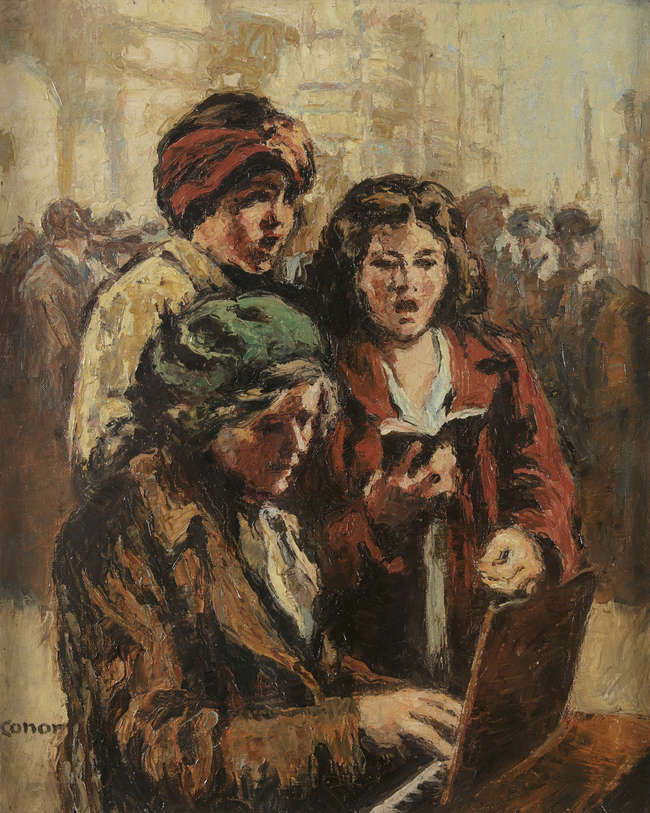
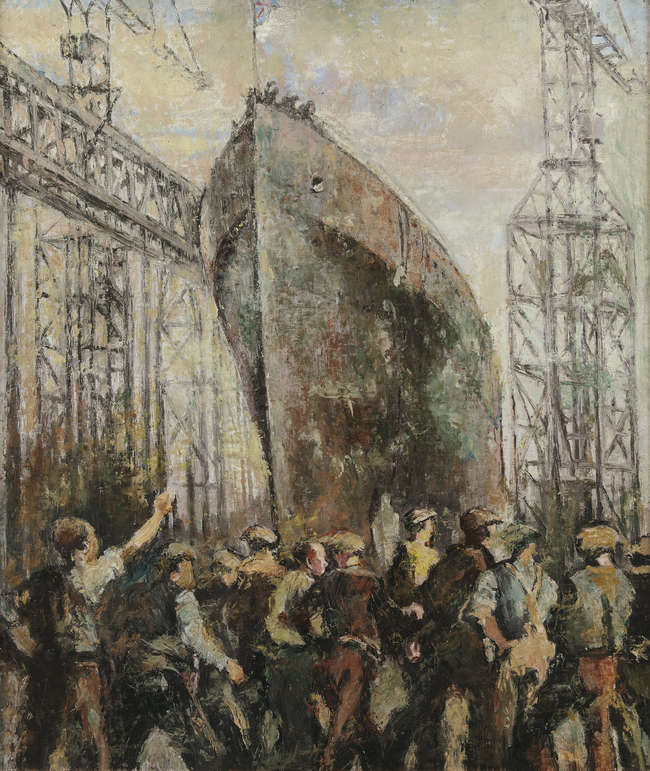
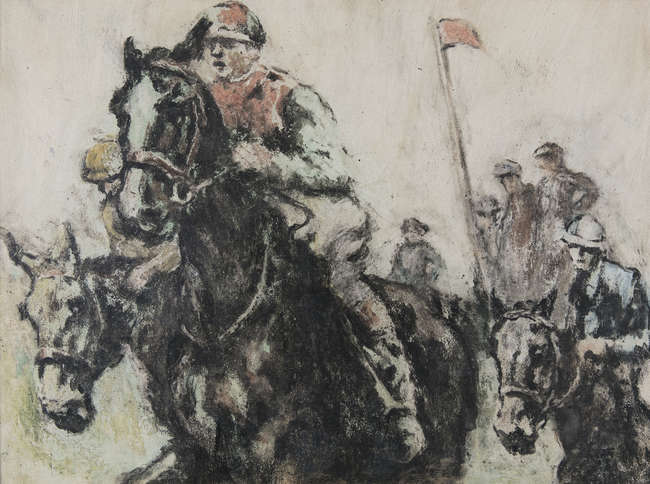
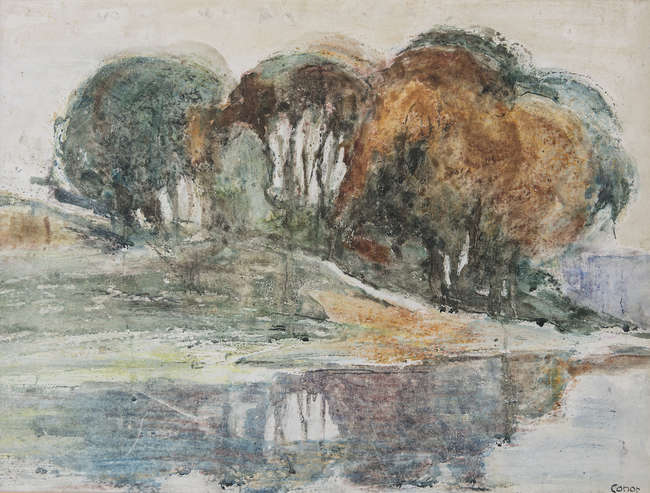
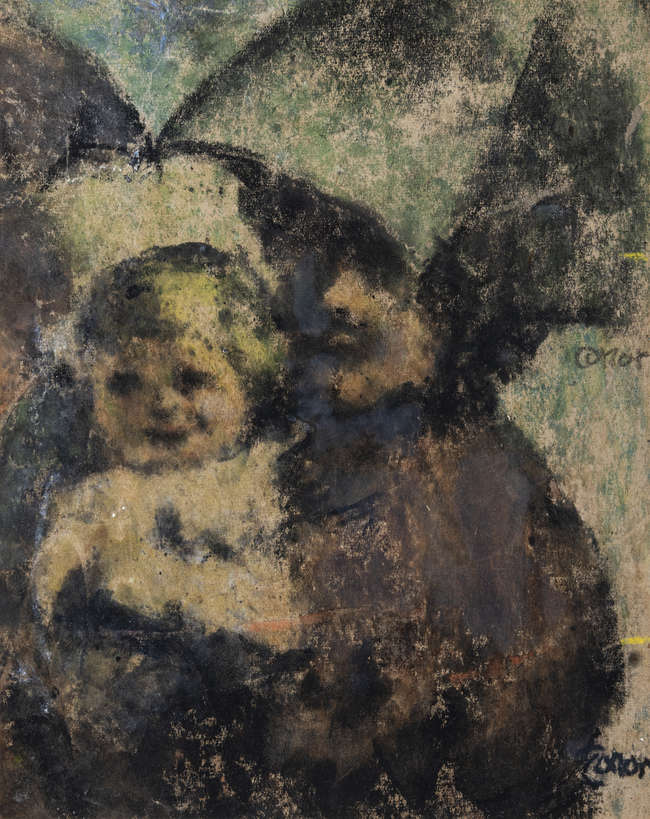
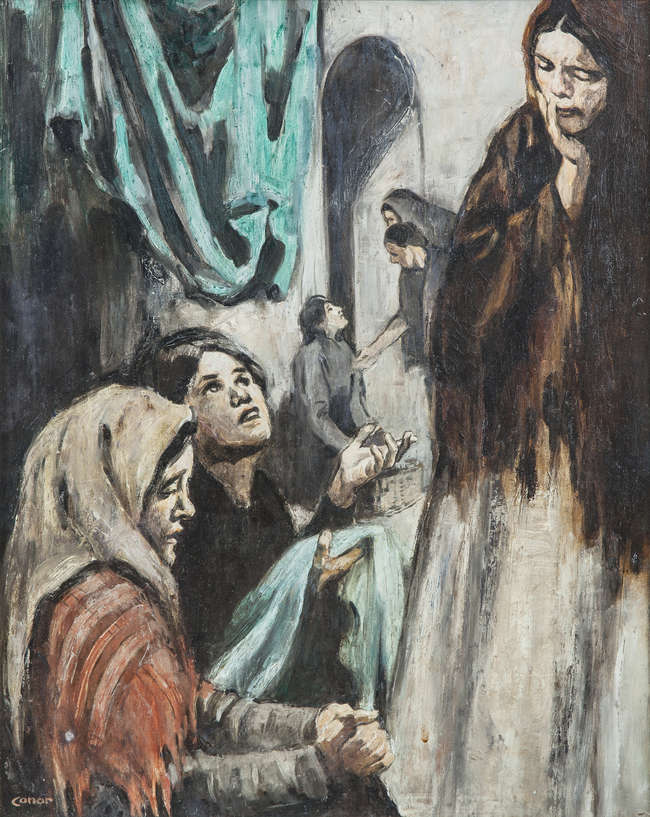
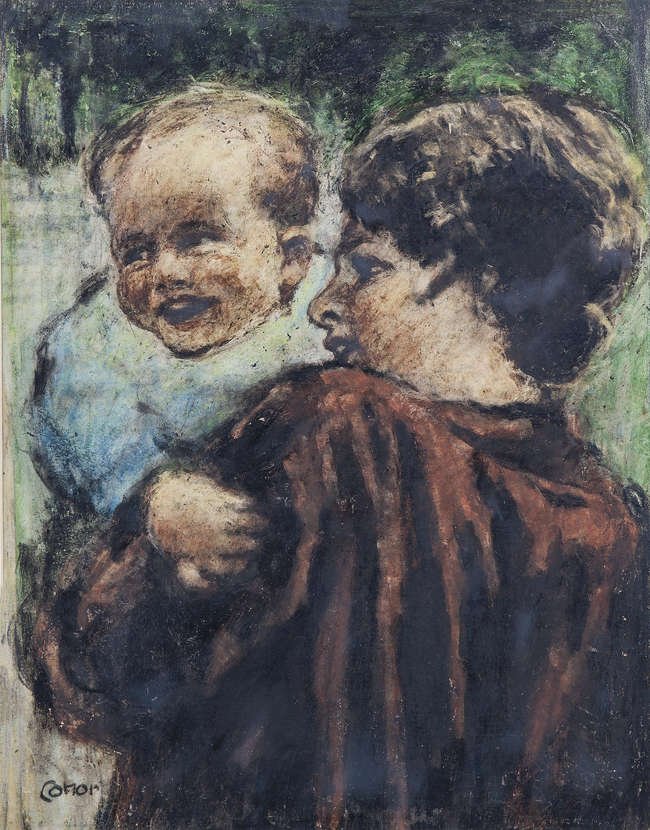

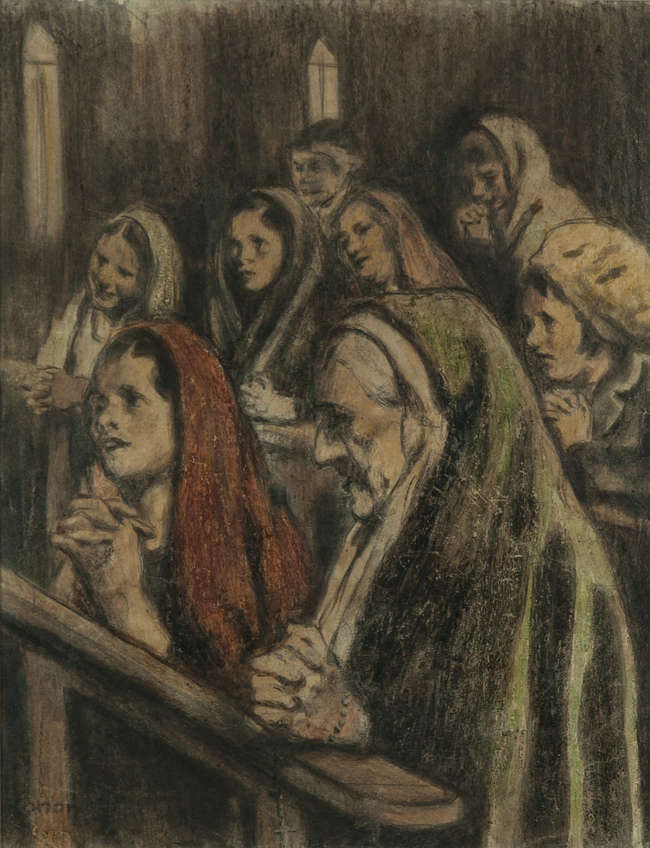




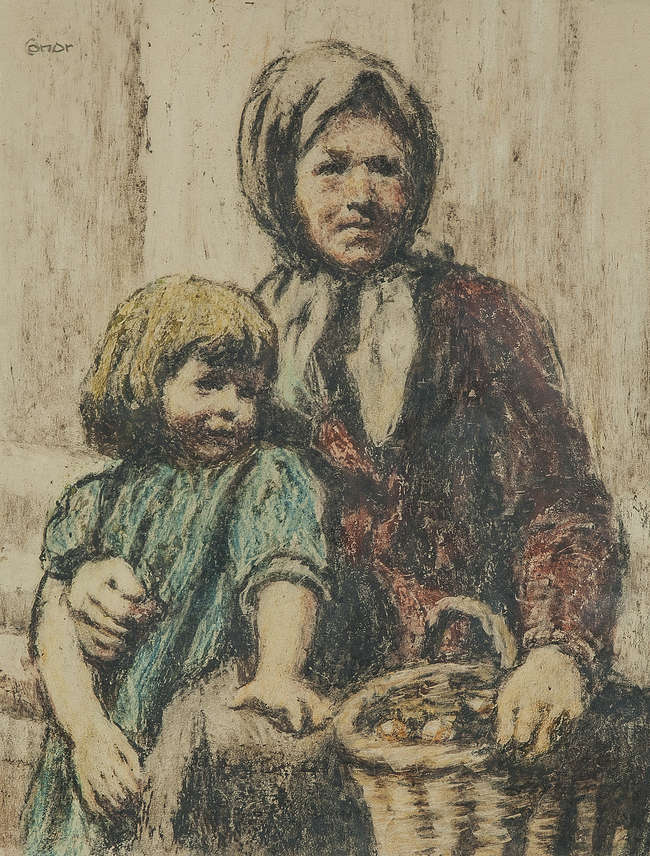

Testen Sie LotSearch und seine Premium-Features 7 Tage - ohne Kosten!
Lassen Sie sich automatisch über neue Objekte in kommenden Auktionen benachrichtigen.
Suchauftrag anlegen